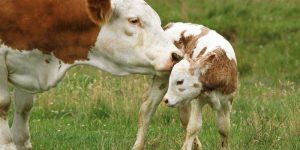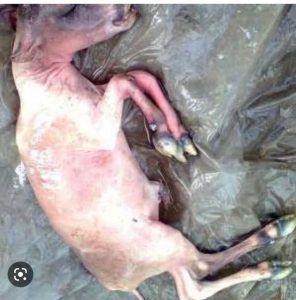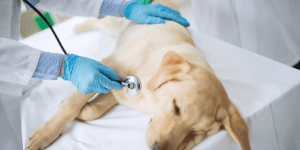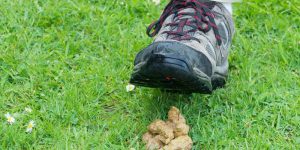Neospora Caninum and Risks to Cattle.
In this article, Holidays4Dogs discusses Neospora Caninum – a disease found worldwide. Neospora lives in cattle and dogs, but only reproduces in canines. One of the ways cattle can develop the disease is by consuming grass contaminated with dog faeces.
If the cow becomes infected with parasites, it is very often deadly. It commonly results in premature birth of infected calves. It is therefore very important to make sure you pick up after your dog, even on lesser-trodden paths in the countryside. Read on to find out more about this important issue. It affects you, your dog and our farming communities.
What is Neospora caninum?
 Neospora is a disease caused by a microscopic protozoan parasite. It is found in many species of animals worldwide, but particularly in intensively farmed cattle.
Neospora is a disease caused by a microscopic protozoan parasite. It is found in many species of animals worldwide, but particularly in intensively farmed cattle.
Neosporosis is one of the most common causes of bovine abortion. Unfortunately, there are no treatments available for the disease in cattle.
In dogs, antibiotics can sometimes be useful. The transmission of the disease correlates with the number of dogs that have access to farmland where cows are fed and watered.
Once the cows ingest grass, feed or water contaminated with dog faeces, the consequences can be drastic.
How do dogs become infected with Neospora Caninum?
It is common for dogs to be exposed to the disease, but thankfully, clinical disease is rare. When dogs do show signs of disease, this tends to be in puppies and younger dogs. The disease is uncommon in older dogs. Some dogs can have the disease their whole life, without anyone realising, but they remain carriers.
Pregnancy in dogs can trigger the protozoa which can then pass to unborn puppies and, subsequently, lead to abortion. Dogs can become infected by consuming raw infected bovine muscle, or foetal material.
Symptoms of Neospora in dogs.
Difficulty swallowing.
Muscle atrophy.
Paralysis.
The earlier Neospora Caninum is diagnosed, the better the outcome. Treatment can last for up to eight weeks.
What can dog owners do to minimise risks?
While there is clear evidence pet dogs, (and foxes) can spread the disease, there is also a need to raise awareness of potential risks of infection from farm dogs themselves.  There is no way to prevent neospora in cattle, so the only defence remaining is to take land management actions.
There is no way to prevent neospora in cattle, so the only defence remaining is to take land management actions.
Therefore, it is important the general public contribute to these efforts when enjoying the great outdoors.
When walking in the countryside, it is just as important to pick up after your dog.
Not only is it very unpleasant for other people to walk among dog faeces, it can clearly cause serious health risks to livestock.
Indeed, it should be noted that it is not just cattle that can be affected by disease. Sarcocytosis is also caused by parasites which infect sheep. It is spread by a number of hosts, including dogs.
Additionally, land frequented by dog walkers where horses and pigs graze, can also become contaminated by infected dog faeces.
Therefore, it very much involves the cooperation of the general public, who should act responsibly when walking their dogs across farmland where livestock graze.
The issue can be devastating for farmers, as well as having an economic impact on their businesses.
Of course, there are not usually waste bins available in open countryside, but this should not be a reason to leave behind dog deposits.
Always remove dog waste – take it to the nearest bin, or take it home. If you don’t fancy carrying dog poop bags in your hand – take a look at our other Holidays4Dogs article for alternative ideas here.
Sources:
A four year longitudinal study sero-epidemiology of neospora caninum in adult cattle from 114 herds in south west England: Associations with age, herd and dam off-spring pairs. K.A. Woodbine et.al. Sept. 2008. BMC Veterinary Research. https://bmcvetres.biomedcentral.com/articles/10.1186/1746-6148-4-35
Neosporosis in Animals. Milton. M. McAllister. Oct 2022. MSD Veterinary manual – professional version. https://www.msdvetmanual.com/generalized-conditions/neosporosis/neosporosis-in-animals.
Neospora caninum. Dr. E. Barker. July 2021. Langford Vets (part of Bristol University). https://www.langfordvets.co.uk/media/1755/neospora-caninum.pdf
Canine neosporosis: perspectives on pathogenesis and management. R.C. Silva and G.P. Machado. April 2016. National Library of Medicine/Dovepress Veterinary Medicine:Research and Reports. https://www.ncbi.nlm.nih.gov/pmc/articles/PMC6055790/#:~:text=Forelimb%20atrophy%20and%20gradual%20muscular,muscle%20from%20the%20affected%20limbs.




